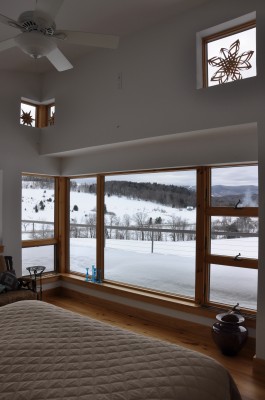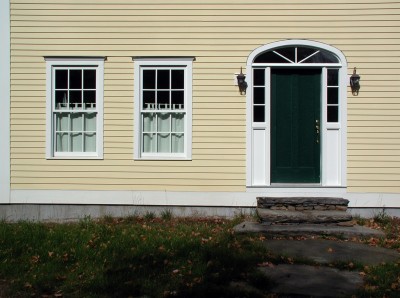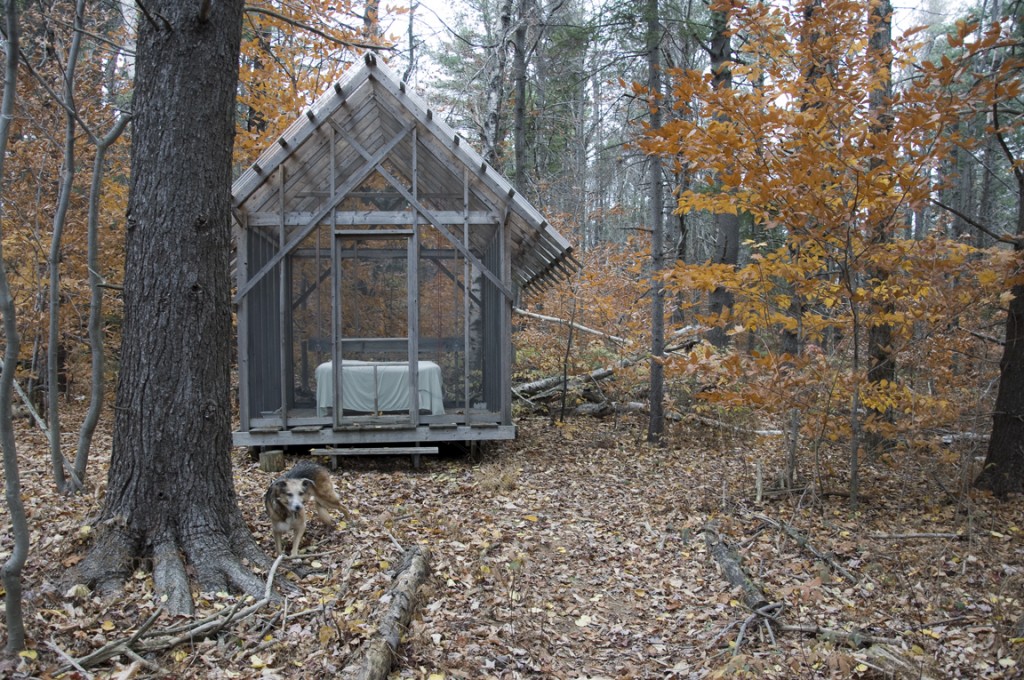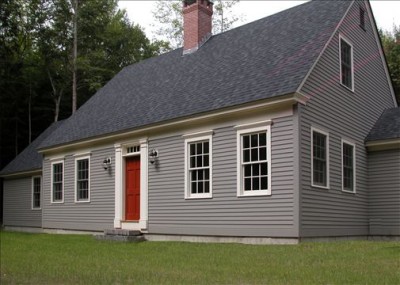Short and anecdotal, this one. Perhaps I need a new category - TMI (too much information) I live in a small, poorly insulated house with a wood stove for heat. The wood stove is rather small and fits in a stone fireplace. The stove is also fairly new and efficient but really doesn't hold a fire all night. So.... In the winter when the nights are cold I have a “system”. In order to insure that I wake up at least once during the night to feed the fire I make sure to drink lots of water before I go to bed. The ramifications of neglecting to do this are chilling. And it keeps me nice and healthy too.
Fern House in the Fall - Beech trees
Budget lessons for the architect (me)
Here is an interesting lesson to learn if I can figure out what it is. Perhaps writing this blog entry will help.I tend to attract the sort of client who wants a 2500 square foot house with porches, hardwood flooring, granite countertops and an attached garage and wants it for $275 K. If they don't flee the office in disgust when I tell them A: can't be done and B: my fees would definitely be more than $3000. (There will of course be someone who will “say” they can) What has happened too often to ignore in the past several years is that clients have come to me with a set of parameters (we architects refer to this as a program) The program consists of needs, wants, site and zoning issues, budget etc. Usually the budget requires a rethinking of needs vs wants and this is where things can get sticky. As I mentioned above, there will always be someone who will tell them they can have it all (meaning: let's wing it) and some clients will seek them out. A few years later when I see the project completed without me it is clear that either the budget was much more “flexible” than it was when they originally came to me or the “needs” list was pared down much more than what I was able to accomplish with them. I know I am not the best salesman, hoping instead that my obvious experience, references and air of quiet competence will engender trust (insert emoticon here) (real men don't use emoticons) There have been times when I have thought of a great solution to a design problem but scrapped it because it was a budget buster only to find out later when the clients went to another architect who came up with the same idea and “sold” it to the client. Discouraging. Perhaps the lesson is that I should take things a bit less personally and realize that other people's idea of budget is more flexible. Of course, I am often the second architect on a project because the first architect designed something too expensive to build...
Connor Homes in Middlebury VT
I'm probably shooting myself in the foot here because this company is sort of on my turf. Unfortunately they are too far away for me to go work for. Connor Homes in Middlebury Vermont has a "pre-engineered and component building system" that is very appealing to me as delivery process for a high end new home. Loads of other companies are doing the same thing but Connor Homes is one of the few who are doing beautiful New England vernacular both well and correctly. As an architect snob I am constantly offended by failed attempts at historically correct detailing both by builders and by other architects.
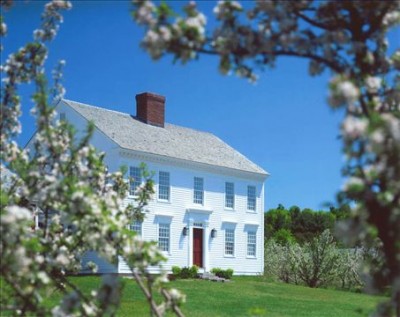
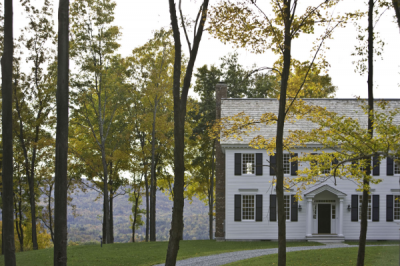
Putney School - continuing education
Last night I attended a tour at the Putney School in nearby Putney VT to get some continuing education credits and to see some of the new buildings from their architect's perspectives. The tour itself was rather slow but having my daughter with me for the first half hour livened things up a bit. She may attend that school when she is older as my town has school choice after 8th grade and the school has an excellent network of x-c trails nicely groomed in the winter. There were no local architects in attendance other than Joe Cincotta and my friend from college who work up the river at Bensonwood. Boy do I not fit in in a group of older white male architects with the occasional shiny and polished female architect. I really must get some rectangly glasses. Are there any local architects anymore? It seems like all the good work is scooped up by firms from up North. In any case, the Putney Field house is a net nada, LEED unobtainium building that is very nice on the inside (I want one) but rather dull looking on the outside. I just really wanted to grab a basketball and shoot some hoops. There was a ski waxing room however and some Concept II's.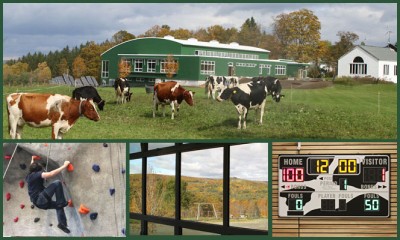
I really like the Michael S Currier Arts center. 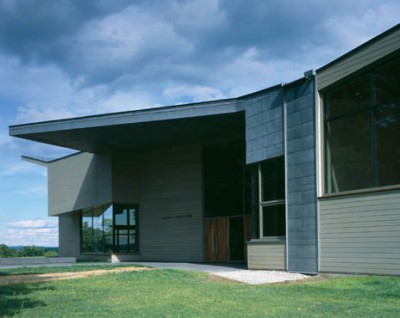 This a modern building that exudes grace and elegance..and it works well too. Details are nicely worked out on a level from the overall to minute details.
The hot link is to a bunch of photos on the Putney School website. This is the sort of building that makes me wish I worked for a larger firm doing institutional and commercial projects. It is very difficult to get this sort of work when you are an anti social sole proprietor lone artist sort who spends all day staring at a computer and muttering.
This a modern building that exudes grace and elegance..and it works well too. Details are nicely worked out on a level from the overall to minute details.
The hot link is to a bunch of photos on the Putney School website. This is the sort of building that makes me wish I worked for a larger firm doing institutional and commercial projects. It is very difficult to get this sort of work when you are an anti social sole proprietor lone artist sort who spends all day staring at a computer and muttering.
BOC Logo contest
I whipped up this as a graphic logo for the Brattleboro Outing Club logo contest.I am a member - nordic skiing - and train on the BOC trails.

Brute Force Collaborative
Brute Force CollaborativeA well done blog with lots of good pictures
Public toilets and Passive Houses!
"It is our goal to advance the green discussion beyond ‘sustainable’ carpets and bike racks – and moving it towards sensible, intelligent green design. This will manifest itself through the documentation of green architects, projects and building techniques that hopefully some of you may find useful."
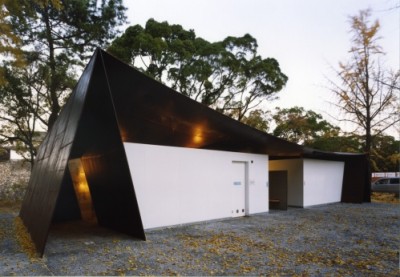
Facebook!
I've started a new Bluetime Collaborative page on facebook. Haven't figured it all out yet but it seems like a slightly less formal place to foster dialogue than this blog where you have to sign in to post comments or send an email to ask a question.
Architectural services are basically "Advice"
File this under “Education of an Architect”People hire me for my professional advice. This may take the form of helping them design a house or do some master planning or a simple addition. It all boils down to advice. Some people try to hire me for drafting but I try to make it clear that if I see something that isn't working or is unnecessarily complicated or un-buildable or even just plain stupid, I'm not going to ignore it. There are often times in the process when the client and I disagree and depending on how important the issue is, I'll push back. If the issue is not so important such as a siding material or color I'll say my piece for the record and then lay off. If the issue is a bigger one and involves the client basically shooting themselves in the foot in terms of budget or previously stated design/function goals or sustainability issues or if it would result in something so ugly that I wouldn't want my name associated then I'll push harder but only up to a point – I'm not much of one for a fight and I'm not the sort who comes into a project with a slick attitude of “I know what's best”. There are times when I've gotten kicked off a job or removed myself because of such issues. Things that had I caved in on would have come back to haunt me later. The architect is an easy entity to blame for design decisions when all is said and done even if there is a good paper trail showing the architect's protestations. Sometimes clients state a set of expectations up front involving budget, design goals, functional requirements and time frame that represent an unsolvable equation. This is where a slick architect or builder has the initial advantage over me. If I am unsuccessful at helping the client re-define these parameters, (sales and education) then I walk. In the past I may have been naïve enough to go forward with the project anyway but when proven right, I got the blame. Sometimes, I see completed projects that I turned down and another architect was hired where it is obvious that the other architect was a better salesman and educator than I and the compromises that I recognized would be necessary are apparent in the final product. Sometimes, I don't take a job and hear later though the grapevine about how the clients fought with the architect and everyone came out with sore feelings and tarnished reputations. The projects pictured on my website (I really need to get out and photograph a bunch of recent projects) never represent what I would have done on a given site and with a similar set of design parameters but instead represent advice – some taken, some not.
A Good Architect-or-Why you should hire one.
I am bringing this post forward because, well, because I like it. As I have mentioned before, much of my work is for people who would never have gone to an architect in the first place, thinking that they could never afford it. Designing a custom home for someone is an incredibly complex endeavor. You can buy a set of plans relatively cheaply that may go 75% of the way towards fulfilling your needs and end up with a descent house. Most people go this route. However, some of my best work to date has been for people who are more concerned with money and value. I have been hired by clients to say “no, you can’t afford it” when they lose focus in the process of building a home and start to make a decision or series of decisions that would blow the budget. A good architect should be able to save a client at least the cost of architectural services if that is one of the stated goals. If you have $250,000 to spend on a house you can buy a plan and build a house that is worth $250,00 or you can spend $20,000 on an architect and build a house for $230,000 that gets you a better looking house with a more efficient and flexible floor plan and nicer spaces that fit your lifestyle more comfortably, a house that costs less to maintain over the longer term. Notice that I keep saying “good architect”. As with any profession there is a wide range of talent and specialties. Always ask for and check references. Find an architect and a builder who you are comfortable with. You need to develop a good relationship with these folks. They’re not just there to sell you something.
This also from an older post: I see many houses around here that would have benefited from some professional design help. It seems that people like to spend more money than they need to . These houses look complicated (if it looks complex then it is expensive) and yet they are obviously intended to be low cost housing. Not many people (or banks) “get” that spending money on an architect or designer up front can save them much more money in the months to follow during construction. Perhaps it is similar to solar hot water systems. Spend 5k to 7k up front and it takes 5 years or so before it is paid off in savings and then it starts saving money. It’s like putting and extra $50 in the bank every month. That’s an extra $6000 dollars over the next 10 years not counting for interest and certainly not counting for rising oil, gas or electricity costs. There was a picture in this month’s “National Geographic” showing a Chinese subdivision from above. Many of the houses had solar hot water systems on the roof. They must be smarter than us.
the cost of power
Living in New England I do get tired of the rampant NIMBYism that goes on here. Wind power is a perfect example. We would rather get our power from coal and let other people deal with all the mining related issues which seem to me to be far more serious than the negative issues associated with wind. Most of those people who have to deal with the negative issues related to coal are poor and so they have much less political power than us middle class New Englanders. I suspect most of them would be happy to get their mountains back and put turbines on the ridges.

"Finally" by Dana Wigdor
 This is a painting from a series by Dana Wigdor that I have long admired for its "Bluetime" feel and its sense of fun. It now resides in my office. I find that art that means the most to me is very strong on mood rather than emotion. Often, art makes me feel the urge to explore my own creativity. I left art school after just one year due to the in-bred nature of the particular school I was going to. I realized that I was better off pursuing an alternative education path and keeping my art personal. I haven't done a very good job of pursuing my art outside of architecture. (or my music either) Maybe it is time to get some canvas and brushes.
This is a painting from a series by Dana Wigdor that I have long admired for its "Bluetime" feel and its sense of fun. It now resides in my office. I find that art that means the most to me is very strong on mood rather than emotion. Often, art makes me feel the urge to explore my own creativity. I left art school after just one year due to the in-bred nature of the particular school I was going to. I realized that I was better off pursuing an alternative education path and keeping my art personal. I haven't done a very good job of pursuing my art outside of architecture. (or my music either) Maybe it is time to get some canvas and brushes.
Typical Simple Construction Drawing Set
This represents a typical Construction Drawing set for a simple house minus a site plan. It represents a bit over 100 hours of labor. Thought y'all might be interested. A more complete set would have framing on a separate sheet, Interior elevations at least of the kitchen and bathrooms, a site plan, Materials schedules usually called out on the floor plans, and separate electrical plans.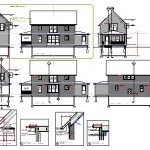
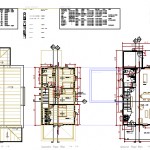
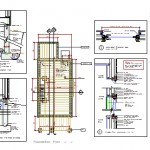
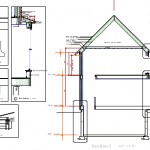
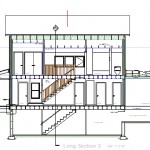
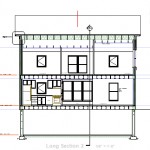
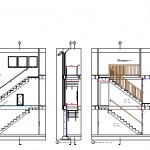
Business of Architecture
Vermont Simple House 1 stock plans are finished !
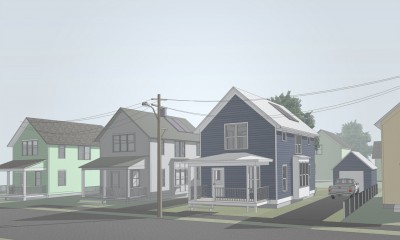 Plans are now up and for sale on one of the largest stock plan publishing houses houseplans.com in their "exclusive architects" section!
My plan is to produce a series of similar houses increasing in scale and amenities and see how it goes. Houseplans.com is a progressive company with a good vision as to where the market is headed. They also have huge site traffic numbers. Keeping my fingers crossed. It took me forever to finish the plans and model for this first house, I suspect I am being a perfectionist again.
Plans are now up and for sale on one of the largest stock plan publishing houses houseplans.com in their "exclusive architects" section!
My plan is to produce a series of similar houses increasing in scale and amenities and see how it goes. Houseplans.com is a progressive company with a good vision as to where the market is headed. They also have huge site traffic numbers. Keeping my fingers crossed. It took me forever to finish the plans and model for this first house, I suspect I am being a perfectionist again.
New Website for Bluetime Collaborative (swinburnearchitect.com)
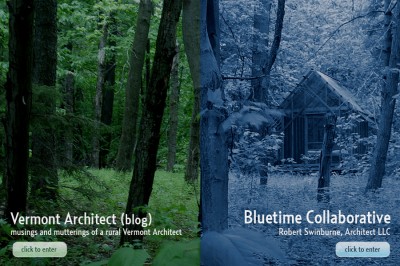 I have a new website designed by Good Bear Productions here at the Cotton Mill in Brattleboro, VT
Check it out! It is very beautiful.
I have learned that I take good photographs but that way too many of my projects are as of yet un-photographed.
I have a new website designed by Good Bear Productions here at the Cotton Mill in Brattleboro, VT
Check it out! It is very beautiful.
I have learned that I take good photographs but that way too many of my projects are as of yet un-photographed.
Old Fashioned Kitchens
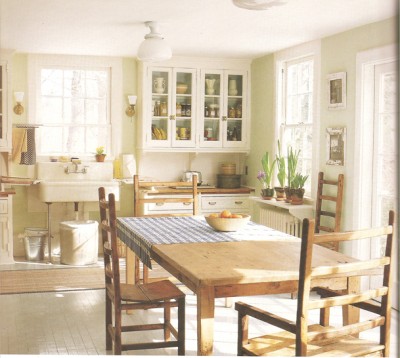 As an architect I am supposed to like a sleek modern kitchen with a huge and functional island and lots of beautiful cabinetry. And I do. But what really melts my emotional side is a big old fashioned kitchen with a large table in the center. - The original "family room". The table is where the family eats their meals, games are played, bills are paid, corn is shucked, dough is rolled... A large pantry is off to one side and may contain the refrigerator and a large window for light. The sink is also large and deep. Of course, such a kitchen calls for a big black woodstove that you could bake in - perhaps a bread oven would be a modern equivalent? It is very hard to find a good image of this sort of kitchen even though those of us with more rural upbringings would find it so familiar. The above image is one I stole out of an old Martha Stewart book I found on a discount rack.
As an architect I am supposed to like a sleek modern kitchen with a huge and functional island and lots of beautiful cabinetry. And I do. But what really melts my emotional side is a big old fashioned kitchen with a large table in the center. - The original "family room". The table is where the family eats their meals, games are played, bills are paid, corn is shucked, dough is rolled... A large pantry is off to one side and may contain the refrigerator and a large window for light. The sink is also large and deep. Of course, such a kitchen calls for a big black woodstove that you could bake in - perhaps a bread oven would be a modern equivalent? It is very hard to find a good image of this sort of kitchen even though those of us with more rural upbringings would find it so familiar. The above image is one I stole out of an old Martha Stewart book I found on a discount rack.
Why there isn't a market for modern homes
A very good article in the Washington Post by Roger K. Lewis on public perceptions of modern architectureWhy there isn't a market for modern homes
Sizing a New House
Most clients say they want either a bigger house because they have kids or a smaller house because the kids have left. It has been my experience over the past few years that 2000 square feet is unacceptably small for most clients. Unfortunately, I most love designing houses in the 1200 to 1800 square foot range. Mostly, people either have too much stuff (oh the stuff I've seen) or are simply used to a large house. Try fitting the retired couple into a 2000 square foot house when they have just spent the last 40 years in a 3000 square foot house. They may initially like the idea but when it comes right down to it, they can't make the mental adjustment. Even if I come up with a floor plan that functions much better than what they have been living with.
Modern vs Conservative (neo-traditional)
Just a small thought. Perhaps I should collect more along these lines. "traditional" design (which is usually not actually very traditional) seems to limit one to creating spaces that are "nice" and "pleasant" and "functional" which is enough for some people. But it is hard, especially when faced with a fantastic view or outdoor space, to create a space with amazing emotional impact within the confines of traditional design.